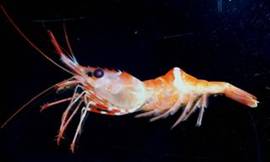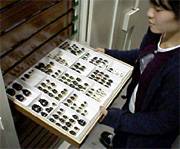
Department of Zoology
The Department of Zoology conducts research in many areas, such as on the classification, habitats, biogeography and molecular phylogeny of various animal groups, with the objective of shedding light on the evolution of each animal group and the resulting increase in diversity.
Research at the Department of Zoology focuses on specimens that are collected mainly from outdoor surveys. Based on the animal group being studied, the department is divided into three divisions-the Division of Vertebrates, the Division of Marine Invertebrates, and the Division of Terrestrial Invertebrates. Each division individually conducts surveys of and research on the respective animal group, collects and manages specimens, creates databases and discloses information on research results and specimen collections. In addition to updating the content of permanent exhibitions and drafting plans for special exhibitions, the Department of Zoology also actively supports various educational programs that cater to a wide range of people ranging from elementary school to graduate students, professors, curators and the general public. The Division of Vertebrates conducts research on mammals, birds, reptiles, amphibians, and fish. Although extensive research has already been done on mammals and birds, details regarding many of the morphological records are yet unknown. The division, while continuing basic research on specimens, is also studying their molecular phylogeny using innovative methods.
The Division of Vertebrates conducts research on mammals, birds, reptiles, amphibians, and fish. Although extensive research has already been done on mammals and birds, details regarding many of the morphological records are yet unknown. The division, while continuing basic research on specimens, is also studying their molecular phylogeny using innovative methods.
New species of fish and species that have hitherto not been seen in Japan are being discovered almost every year, and the division is conducting research into their genealogy using comparative anatomy and molecule-based methods. Marine invertebrates boast a rich diversity of animal phylums, each with its diversified lifestyle; ocean habitat; benthic, flotage, natatorial and parasitic characteristics. Researchers at the Division of Marine Invertebrates focus on the classification and habitat of the animal group that forms their area of specialization.
Marine invertebrates boast a rich diversity of animal phylums, each with its diversified lifestyle; ocean habitat; benthic, flotage, natatorial and parasitic characteristics. Researchers at the Division of Marine Invertebrates focus on the classification and habitat of the animal group that forms their area of specialization.
 Division of Terrestrial Invertebrates conducts research on insects, spiders, mites, centipedes, scorpions and other terrestrial arthropods. Terrestrial invertebrates, among all animal groups, are made up of an overwhelmingly large number of species. Little information is known even among the species exclusive to Japan, with several new species and species that have hitherto not been seen in Japan being discovered every year.
Division of Terrestrial Invertebrates conducts research on insects, spiders, mites, centipedes, scorpions and other terrestrial arthropods. Terrestrial invertebrates, among all animal groups, are made up of an overwhelmingly large number of species. Little information is known even among the species exclusive to Japan, with several new species and species that have hitherto not been seen in Japan being discovered every year.
Research at the Department of Zoology focuses on specimens that are collected mainly from outdoor surveys. Based on the animal group being studied, the department is divided into three divisions-the Division of Vertebrates, the Division of Marine Invertebrates, and the Division of Terrestrial Invertebrates. Each division individually conducts surveys of and research on the respective animal group, collects and manages specimens, creates databases and discloses information on research results and specimen collections. In addition to updating the content of permanent exhibitions and drafting plans for special exhibitions, the Department of Zoology also actively supports various educational programs that cater to a wide range of people ranging from elementary school to graduate students, professors, curators and the general public.
Division of Vertebrates

New species of fish and species that have hitherto not been seen in Japan are being discovered almost every year, and the division is conducting research into their genealogy using comparative anatomy and molecule-based methods.
Division of Marine Invertebrates

Division of Terrestrial Invertebrates

Specimen collection of the Department of Zoology
The specimen collection of the Department of Zoology has a total of about 1.8 million items. These include approximately 20,000 specimens of terrestrial mammal species, including the Yoshimoto collection; more than 7,000 specimens of marine mammals; about 5,000 taxidermy specimens of birds; and approximately 5,000 specimens of reptiles and amphibians. Specimens of over 5,000 fish species, including type specimens of 230 species, account for about 1.3 million of the total specimen collection. The approximately 280,000 specimens of marine invertebrates include Porifera (sponges), Cnidaria, Parasitic helminth (Platyhelminthes and Aschelminthes), mollusk, Polychaete annelid, Crustacean, and Echinoderm specimens. Specimens of terrestrial invertebrates amount to about 150,000, and include Lepidoptera, Hymenoptera, Diptera, Neuroptera, Coleoptera, Libellulidae, Orthoptera, Hemiptera, Apterygota, and Arachnida specimens, and about 5,100 type specimens.